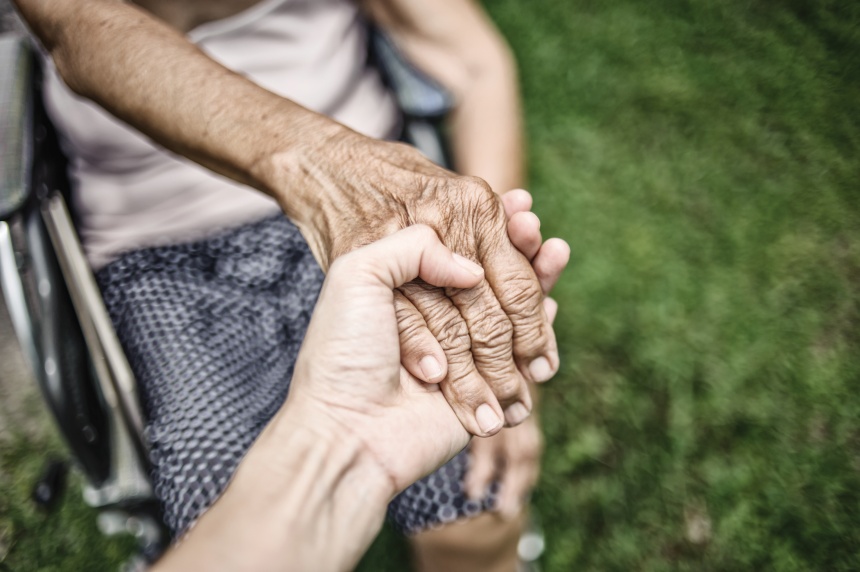For Tony Tran, the biggest problem was the isolation and cultural pressure to keep it in the family. Barry Applebaum struggled with the stress and trying to remain stoic for his kids. Larry Bocchiere lost a sense of normalcy when he had to retire from his job.
What these men, and millions of others like them, have in common is family caregiving — providing ongoing help for an aging parent, a spouse who is ill, or both.
Although women still make up the majority of family caregivers, more and more men are stepping into the role: Some 40 percent of family caregivers are now men, according to the most recent research from AARP and the National Alliance for Caregiving, up from 33 percent a decade ago. Little is known about the impact of COVID-19 on this trend, but it’s safe to assume that more men were called on to pitch in with caregiving during this crisis as well.
Like their female counterparts, these 16 million male family caregivers face tremendous challenges as they simultaneously try to balance work and raising a family with the physical and emotional demands of helping an ailing or aging loved one. But they’re also dealing with issues unique to their gender — from sometimes being less familiar and comfortable with the more personal and intimate aspects of caregiving
to fighting stereotypes about the nature of their role.
“They’ve been brought up to think they can do it all themselves, that asking for help is a sign of weakness.”
One upshot: Despite their large and growing numbers, male caregivers often feel invisible and ignored, says Christina Irving, a social worker with the Family Caregiver Alliance Bay Area Caregiver Resource Center.
That may be partly because they tend to distance themselves from the label. “Many men don’t self-identify as caregivers,” Irving says. “They just see themselves as the good husband, son, or grandson.”
Nearly half of male family caregivers are helping an aging parent or in-law, making this by far the most common care scenario, according to the AARP study. And contrary to popular misconception, these men are not just lending an occasional hand: Some 63 percent of male caregivers are their loved one’s primary helper, the research shows. Count Tony Tran among them. Tran came to San Francisco with his family from Vietnam as a child. As the only one of his six siblings who is unmarried, the bulk of caregiving has fallen to him as his mother’s dementia has worsened.
“While she’s physically healthy, she needs 24/7 supervision because she wanders,” he says.
Tran took a three-month unpaid leave from his job to care for her full-time. It wasn’t long before he was physically and emotionally exhausted. Even with community support services and some help from paid caregivers, it was still a struggle. He says he thought he could do it all but never felt he was doing enough. “Being a caregiver can be very lonely and isolating, especially being an Asian man,” he explains.
Cultural pressures and a tradition of filial duty make the situation even more stressful. No matter how hard it is, he says, you don’t ask for help. That’s why his new job is so important. Tran now works part-time with the Family Caregiver Alliance in the Bay Area, doing outreach with their many Asian communities.
One of the biggest challenges for men is taking on tasks that go well beyond stereotypical male roles. Some 44 percent of male family caregivers help their loved one get in and out of bed or chairs; one in three assist with getting dressed and going to the bathroom; roughly a quarter help with eating, bathing, and showering, according to the AARP report. More than half are also providing medical and nursing help, including complex tasks like wound care, injections, and tube feeding.
“We’re managing medications, cooking, the whole nine yards,” says Jean Accius, senior vice president of global thought leadership at AARP.
Men are also less likely to ask for help and may be more reluctant to accept it if offered, says Carol Levine, former director of the families and healthcare project at the United Hospital Fund in New York. She says, “They’ve been brought up to think they can do it all themselves, that asking for help is a sign of weakness.”
That seems to be particularly true when the person men are caring for is their spouse. Although just over half of male family caregivers reported they had some help from other unpaid caregivers, more than three-quarters of those caring for a spouse did not.
Barry Applebaum, 63, has experienced both kinds of caregiving — and dealt with both in different ways. He was raising five kids in a blended family in Lancaster, Pennsylvania, while juggling a job in sales when he first began caring for his mother. She had multiple health problems and lived with his family for four years after his dad died. But eventually, her physical and mental health issues became too much to deal with, and he made the tough decision to place her in a long-term care facility. “It was very stressful,” he says.
After his mother’s death, Applebaum thought his caregiving days were behind him. But just a few years later, his wife suffered a major stroke at age 50. “At first, we were under the impression she would get better, but she’s never going to be who she was,” Applebaum says. “No one thinks at age 50 your wife is going to become a quadriplegic. She needed help with everything.”
And then there is the financial strain. Huge medical bills and other costs shrank their bank account. “I changed jobs three times because I had to stay home and care for her — the insurance didn’t cover what she needed,” he says.
The two had been looking forward to becoming empty nesters, traveling and living life together. “All of our dreams were taken away from us,” he says.
It’s very different from caring for a parent, he says. “My wife’s become my child. I had to realize, I can’t rely on my kids. And a lot of your friends eventually disappear. You’re really alone.”
Sometimes, he wonders. “Can I do this for the next 30 years? Do I want to?” he asks.
His kids encouraged him to talk to someone, and he eventually found the Well Spouse Association, a group he calls lifesaving. “For me, it was about relating to people who were in my shoes,” he says. “This is the new normal.”
Men and women also often face different challenges juggling caregiving and work. About two-thirds of male caregivers in the AARP survey were likely to work full-time while caring for a loved one, compared with 55 percent of women. Unlike in some European countries, there’s no national paid family leave in the United States. The Family and Medical Leave Act assures some employees time off to care for a sick parent or child without putting their job in jeopardy, but employers don’t have to pay you.
Only a handful of states — California, Colorado, New York, New Jersey, Rhode Island, Washington, Massachusetts, Connecticut, and Oregon — and the District of Columbia have approved a paid family leave policy. But many caregivers must use vacation and sick days, or cut back to part-time employment. Some quit their jobs altogether.
The AARP survey found, for example, that 62 percent of male caregivers had to make changes in their jobs to accommodate their responsibilities for their loved one, including 15 percent who took a leave of absence or shifted from full- to part-time work, and 6 percent who retired early or gave up working entirely. Larry Bocchiere falls into that last category. He chose to retire early from the U.S. Postal Service so that he could care for his late wife, who had emphysema, a progressive lung disease.
Now 70 and remarried in Bethel, Connecticut, Bocchiere looks back at his time as a caregiver. “The first few years weren’t too bad, but as she got sicker, her activity decreased,” he says. “I had to assume a lot of household duties and eventually help her bathe and even get to the bathroom.”
It wasn’t easy.
“You learn how to do these things because you have to,” he says.
How was it different for him as a man?
“A man looks at a problem and tries to fix it,” he says. “It’s real easy to get frustrated when you can’t fix it. That’s what happens with a chronic illness.”
Their town had no services for caregivers like him. Bocchiere eventually found a spousal support group about 20 miles away and “started learning how to keep myself sane.”
Getting help from a community of like-minded individuals is the key to survival as a caregiver. If men face special issues, what one sees time and time again is that the instinct to try to go it alone — whether the caregiver is male or female — is a recipe for disaster. The more society can acknowledge the challenges of caregiving, the more we can help people get information and destigmatize the stay-at-home caregiver, the sooner people can reach out to others for help and support, says Irving. “It’s better for the caregiver and better for the person they’re caring for.”
Liz Seegert is an independent health journalist covering aging, boomers, and related policy issues. Her work has appeared in TIME Health, Consumer Reports, Forbes.com, The Los Angeles Times, and other outlets. For more, visit lizseegert.com.
This article first appeared on considerable.com. Reprinted with permission.
This article is featured in the March/April 2021 issue of The Saturday Evening Post. Subscribe to the magazine for more art, inspiring stories, fiction, humor, and features from our archives.
Featured image: Africa Studio / Shutterstock
Become a Saturday Evening Post member and enjoy unlimited access. Subscribe now



